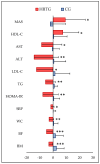High-Intensity Interval Training Reduces Liver Enzyme Levels and Improves MASLD-Related Biomarkers in Overweight/Obese Girls
- PMID: 39796598
- PMCID: PMC11723383
- DOI: 10.3390/nu17010164
High-Intensity Interval Training Reduces Liver Enzyme Levels and Improves MASLD-Related Biomarkers in Overweight/Obese Girls
Abstract
Background/objectives: Despite the abundant body of evidence linking high-intensity interval training (HIIT) to cardiometabolic markers, little is known about how HIIT affects liver enzymes, particularly in obese adolescents. This study aimed to investigate the effects of HIIT on metabolic dysfunction-associated steatotic liver disease (MASLD)-related biomarkers in overweight/obese adolescent girls.
Methods: Thirty-three overweight/obese adolescent girls (age, 17.0 ± 1.15 yr.; body mass index, 33.3 ± 4.77 kg/m2) were randomly assigned to HIIT (n = 17) or control (n = 16) groups. The HIIT group participated in a nine-week HIIT program (three times weekly) without caloric restriction. Maximal aerobic speed, body composition indexes, blood pressure, MASLD-related biomarkers [liver enzymes (alanine aminotransferase (ALT) and aspartate aminotransferase (AST)), plasma lipids, uric acid, platelet count, and homeostasis model assessment index for insulin-resistance (HOMA-IR)] were examined at baseline and after the intervention.
Results: Significant "time × group" interactions were found for body composition indexes, systolic blood pressure, maximal aerobic speed, liver enzymes ALT and AST, plasma lipids, glucose, and HOMA-IR. The HIIT program resulted in an increase in maximal aerobic speed (p = 0.035) and a decrease in body composition and plasma lipids (p < 0.01), systolic blood pressure (p = 0.011), ALT (p = 0.013), AST (p = 0.012), and HOMA-IR (p = 0.01), but no significant changes in uric acid and platelet count. None of these markers changed in the control group.
Conclusions: HIIT resulted in an improvement in MASLD-related biomarkers. HIIT could be an effective exercise therapy to prevent and reverse MASLD in adolescents with obesity.
Keywords: insulin resistance; lipid profile; liver enzyme; nonalcoholic fatty liver disease; obesity; physical training.
Conflict of interest statement
The authors declare no conflicts of interest.
Figures


Similar articles
-
Impact of L-Citrulline Supplementation and HIIT on Lipid Profile, Arterial Stiffness, and Fat Mass in Obese Adolescents with Metabolic-Dysfunction-Associated Fatty Liver Disease: A Randomized Clinical Trial.Nutrients. 2025 Jan 23;17(3):402. doi: 10.3390/nu17030402. Nutrients. 2025. PMID: 39940261 Free PMC article. Clinical Trial.
-
Low-Frequency HIIT Improves Body Composition and Aerobic Capacity in Overweight Men.Med Sci Sports Exerc. 2020 Jan;52(1):56-66. doi: 10.1249/MSS.0000000000002097. Med Sci Sports Exerc. 2020. PMID: 31343521 Clinical Trial.
-
Effects of school-based high-intensity interval training on body composition, cardiorespiratory fitness and cardiometabolic markers in adolescent boys with obesity: a randomized controlled trial.BMC Pediatr. 2022 Mar 1;22(1):112. doi: 10.1186/s12887-021-03079-z. BMC Pediatr. 2022. PMID: 35232402 Free PMC article. Clinical Trial.
-
Effect of high-intensity interval training on cardiometabolic risk factors in childhood obesity: a meta-analysis.J Sports Med Phys Fitness. 2021 May;61(5):743-752. doi: 10.23736/S0022-4707.20.11329-X. J Sports Med Phys Fitness. 2021. PMID: 33975429
-
High-intensity interval training in overweight and obese children and adolescents: systematic review and meta-analysis.J Sports Med Phys Fitness. 2019 Feb;59(2):310-324. doi: 10.23736/S0022-4707.18.08075-1. Epub 2018 Mar 27. J Sports Med Phys Fitness. 2019. PMID: 29589408
Cited by
-
Nutritional Status and Ergogenic Aids in Performance During Exercise and Sports.Nutrients. 2025 Mar 31;17(7):1224. doi: 10.3390/nu17071224. Nutrients. 2025. PMID: 40218982 Free PMC article.
-
Two-Year Mediterranean Diet Intervention Improves Hepatic Health in MASLD Patients.Foods. 2025 May 14;14(10):1736. doi: 10.3390/foods14101736. Foods. 2025. PMID: 40428516 Free PMC article.
-
Systematic Review: Does Exercise Training Influence Ghrelin Levels?Int J Mol Sci. 2025 May 15;26(10):4753. doi: 10.3390/ijms26104753. Int J Mol Sci. 2025. PMID: 40429895 Free PMC article.
References
-
- van Son K.C., Te Nijenhuis-Noort L.C., Boone S.C., Mook-Kanamori D.O., Holleboom A.G., Roos P.R., Lamb H.J., Alblas G., Coenraad M.J., Rosendaal F.R., et al. Prevalence of metabolic dysfunction-associated steatotic liver disease (MASLD) in a middle-aged population with overweight and normal liver enzymes, and diagnostic accuracy of noninvasive proxies. Medicine. 2024;103:e34934. doi: 10.1097/MD.0000000000034934. - DOI - PMC - PubMed
Publication types
MeSH terms
Substances
LinkOut - more resources
Full Text Sources

